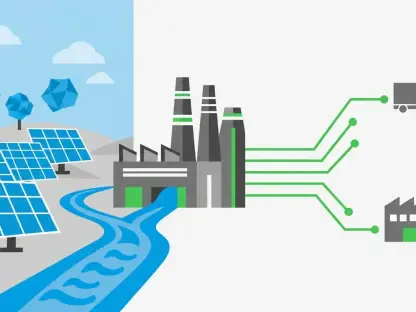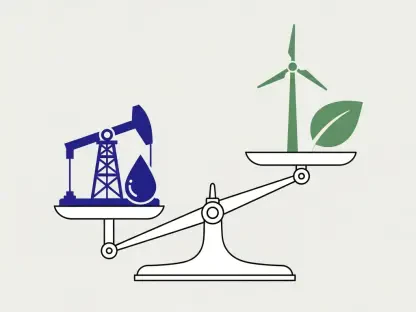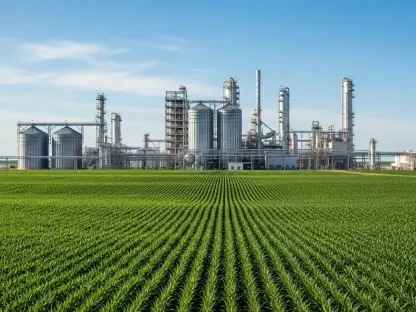In a world increasingly driven by the urgent need to combat climate change, the Keadby Next Generation Power Station Project near Scunthorpe, Lincolnshire, emerges as a beacon of innovation in the UK’s energy landscape, promising a transformative impact. This ambitious undertaking by Keadby Next Generation Limited, a subsidiary of SSE Plc, proposes a combined cycle gas turbine (CCGT) power station with an impressive capacity of up to 910 megawatts (MW). What makes this project truly remarkable is its pioneering design to operate on 100% hydrogen, 100% natural gas, or a blend of both, setting a new standard for low-carbon energy production. Aligned with the UK’s commitment to achieving net-zero emissions by 2050, this development promises to significantly reduce greenhouse gas emissions compared to conventional fossil fuel-based facilities. Spanning a 77.1-hectare site adjacent to the existing Keadby 1 and Keadby 2 Power Stations, the project not only leverages established infrastructure but also introduces cutting-edge technology to meet modern energy demands. As it enters a crucial phase of public consultation and examination, the initiative stands poised to redefine how sustainable power generation can be integrated into national grids, sparking curiosity about its potential to transform the energy sector.
The Vision of a Hydrogen Future
Pioneering Low-Carbon Energy
The capability of the Keadby Power Station to seamlessly switch between hydrogen and natural gas as fuel sources marks it as a trailblazer in the UK’s journey toward decarbonization. This dual-fuel flexibility ensures that the facility can meet immediate energy needs with natural gas while preparing for a future where hydrogen, a cleaner and more sustainable option, could become the dominant fuel. By embracing hydrogen-ready technology, the project directly addresses the pressing challenge of reducing carbon emissions in power generation. This forward-thinking approach not only supports national climate goals but also positions the station as a model for other energy projects aiming to transition away from traditional fossil fuels. The potential to operate on 100% hydrogen highlights a commitment to innovation, offering a glimpse into a future where energy production could have a minimal environmental footprint.
Beyond its technological innovation, the project’s alignment with broader environmental objectives underscores its significance in the energy sector. The emphasis on hydrogen as a primary fuel source reflects a strategic response to global calls for cleaner energy alternatives. This initiative could serve as a catalyst for further investment in hydrogen infrastructure across the UK, encouraging the development of supply chains and storage solutions necessary for widespread adoption. Additionally, by demonstrating the viability of hydrogen-powered generation at such a large scale, the project may inspire similar endeavors, fostering a ripple effect that accelerates the shift to low-carbon systems. The implications of this development extend far beyond Lincolnshire, potentially influencing energy policies and practices on a national and even international level.
Driving Technological Advancement
The integration of hydrogen-ready technology at the Keadby facility represents a significant leap forward in power generation capabilities. Unlike traditional plants that are locked into specific fuel types, this station’s design allows for adaptability in response to evolving energy markets and regulatory landscapes. Such versatility ensures that the facility remains relevant and efficient as the UK progresses toward its net-zero targets. The project also highlights the growing role of hydrogen as a key player in the energy mix, pushing the boundaries of what is possible in large-scale power production. This technological stride could pave the way for advancements in hydrogen combustion and storage, addressing some of the current challenges associated with its use as a mainstream fuel.
Moreover, the project’s focus on cutting-edge solutions extends to its potential impact on research and development within the energy sector. By serving as a real-world testing ground for hydrogen applications, the Keadby station could generate valuable data and insights that inform future innovations. Collaboration with industry experts and academic institutions may further enhance the project’s contributions to technological progress, fostering a knowledge-sharing ecosystem. The successful implementation of this dual-fuel system could also attract attention from global energy leaders, positioning the UK as a frontrunner in sustainable power generation. This development is not just about meeting current energy demands but about shaping the trajectory of energy technology for decades to come.
Project Scope and Infrastructure
A Comprehensive Development Plan
The Keadby Next Generation Power Station Project encompasses far more than just a power generation facility; it is a meticulously planned endeavor with a wide array of components designed for efficiency and sustainability. At its core is the 910 MW CCGT power station, engineered to deliver substantial energy output while maintaining fuel flexibility. Supporting this are intricate hydrogen and natural gas supply pipelines, ensuring a reliable fuel source regardless of the operational mode. Electrical connections to the National Grid facilitate seamless integration into the UK’s energy distribution network, while water management systems, including intake from the Stainforth and Keadby Canal and discharge to the River Trent, address cooling and operational needs. Additionally, new access routes and temporary construction zones are planned to streamline the building process, reflecting a holistic approach to project execution that prioritizes both functionality and practicality.
Beyond the immediate infrastructure, the project incorporates forward-looking elements such as land allocation for future carbon capture facilities, aligning with regulatory requirements under the Carbon Capture Readiness (Electricity Generating Stations) Regulations 2013. This proactive measure ensures that the station is prepared to adapt to stricter environmental standards over time. The inclusion of landscaping initiatives aimed at enhancing biodiversity further demonstrates a commitment to integrating the development into the local environment with minimal disruption. Spanning a significant 77.1-hectare site near existing Keadby stations, the project leverages proximity to established infrastructure to optimize costs and logistical efficiency. This comprehensive scope illustrates a vision that balances immediate operational goals with long-term environmental and regulatory considerations, setting a high standard for infrastructure projects of this nature.
Environmental Mitigation Efforts
Recognized as an Environmental Impact Assessment (EIA) development under the Infrastructure Planning (Environmental Impact Assessment) Regulations 2017, the Keadby project places a strong emphasis on understanding and addressing its ecological footprint. A detailed Environmental Statement accompanies the Development Consent Order (DCO) application, providing an in-depth analysis of potential impacts on local ecosystems, water resources, and landscapes during both construction and operational phases. This thorough documentation ensures that decision-makers and the public are fully informed about the environmental implications of the project. Measures such as careful management of water connections to local bodies like the Stainforth and Keadby Canal are implemented to safeguard these resources, reflecting a dedication to preserving the natural surroundings amidst industrial development.
In addition to assessment, the project incorporates tangible actions to mitigate environmental harm, such as landscaping plans designed to enhance biodiversity across the site. These initiatives aim to create habitats and green spaces that support local wildlife, offsetting some of the disruptions caused by construction activities. The allocation of space for future carbon capture technology further underscores a proactive stance on reducing greenhouse gas emissions over the long term. By embedding these mitigation efforts into the project’s framework, the developers demonstrate a commitment to balancing industrial progress with environmental stewardship. This approach not only addresses immediate concerns but also contributes to the broader goal of sustainable development in the region, ensuring that the benefits of cleaner energy do not come at the expense of the natural environment.
Public Engagement and Legal Process
Transparent Community Involvement
Public participation forms a cornerstone of the Keadby Next Generation Power Station Project, ensuring that local voices play a pivotal role in shaping its outcome. The Development Consent Order (DCO) application, accepted by the Planning Inspectorate (PINS) on behalf of the Secretary of State for Energy Security and Net Zero, has opened a critical window for community input. Detailed project documents, including the draft DCO, Environmental Statement, plans, and maps, are readily accessible for free on the PINS website under reference EN0110001, as well as on the project’s dedicated online platform. For those preferring physical access, locations such as Scunthorpe Public Library and Crowle Community Hub offer opportunities to review materials without charge. Alternative methods, including email support, a 24-hour voicemail service, and postal correspondence, cater to diverse needs, ensuring that barriers to engagement are minimized.
The process for public involvement is structured to be as inclusive as possible, with individuals encouraged to register as Interested Parties through PINS to submit representations or objections by the specified deadline later this year. This formal mechanism allows community members to directly influence the examination phase, whether by expressing support or raising concerns about the project’s impact. Assistance is readily available through PINS contact channels, including phone and email support, to guide participants through the submission process. This emphasis on transparency and accessibility highlights the project’s commitment to integrating community perspectives into a nationally significant infrastructure initiative. By fostering an open dialogue, the developers aim to build trust and ensure that the project reflects a broad spectrum of stakeholder input.
Navigating Legal Requirements
The legal and administrative framework surrounding the Keadby project is as complex as the infrastructure itself, reflecting the scale and significance of the development. The DCO application, accepted under Section 55 of the Planning Act 2008, seeks extensive powers, including compulsory acquisition of land, temporary land use, and modifications to local highways. These legal provisions are essential to facilitate the project’s footprint, which impacts land use and infrastructure across a wide area. The formal acceptance by PINS marks a pivotal step, initiating a rigorous evaluation process that will scrutinize every aspect of the proposal. This structured approach ensures that the development adheres to national planning standards while addressing local implications through a transparent examination phase.
Furthermore, the legal process underscores the necessity for coordination with local authorities and stakeholders to manage the project’s broader effects on the region. The inclusion of provisions for infrastructure changes, such as bridge replacements and access route developments, highlights the intricate planning required to integrate the power station into the existing landscape. As part of the examination, environmental and social impacts documented in the Environmental Statement will be thoroughly assessed to ensure compliance with regulatory frameworks. This legal scrutiny not only safeguards the integrity of the planning process but also provides a platform for addressing potential conflicts or concerns raised by affected parties. The outcome of this process will ultimately determine how the project moves forward, balancing national energy needs with local considerations.
Reflecting on a Sustainable Legacy
Looking back, the journey of the Keadby Next Generation Power Station Project captured a pivotal moment in the UK’s pursuit of a sustainable energy future. The acceptance of the Development Consent Order application by the Planning Inspectorate set a precedent for how innovative projects could navigate complex legal and environmental landscapes. The comprehensive scope, from the dual-fuel CCGT facility to biodiversity enhancements, illustrated a balanced approach that prioritized both progress and precaution. Public engagement efforts ensured that community voices shaped the narrative, fostering a sense of shared responsibility. As the examination phase unfolded, the project’s hydrogen-ready design stood as a testament to the potential of cleaner energy solutions. Moving forward, stakeholders should focus on leveraging the insights gained to advocate for expanded hydrogen infrastructure and supportive policies. Collaborative efforts between industry, government, and local communities will be crucial to replicate such initiatives, ensuring that the legacy of this project inspires a broader transition to low-carbon energy systems across the nation.









